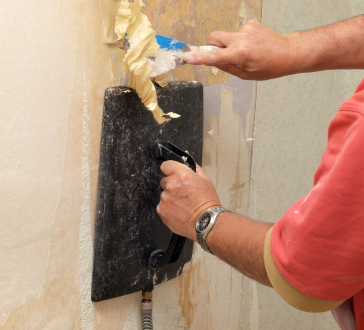Wall marks and stains can be really tricky to remove from painted walls carefully and properly. We’ve all had a random mark or scuff appear on our walls every now and then. Sometimes we know exactly where the mark has come from, whether it be a passing bag or shoe scuff, but often random scuffs can be bad news for your paint job. Some blemishes seem almost impossible to remove and if done incorrectly, can damage your painting. If you don’t remove marks and scuffs from walls properly, then you could be looking at a full repaint of the area or cause further damage to the walls. With this in mind, here are some top tips for how to care for painted walls.
Cleaning Painted Walls
If you just want to generally clean painted walls in your home, then there are some tips you should follow. First, start by dusting the walls using a soft cloth, as this will prevent any dirt and dust from being smeared around the rest of the wall. Next, use warm, soapy water using a very small amount of mild cleaning detergent, such as washing up liquid and a soft cloth. Try not to over dampen your cloth or sponge, as this could result in water stains being left on your paintwork. Once you’ve applied the cleaning solution, leave for 5 minutes and then wipe over using clean water.
Removing Oil From Paintwork
In your home, there are certain areas that are likely to have more issues than others when it comes to cleaning painted walls and surfaces. The kitchen is likely to have oil and grease marks and, if left, can stain. To remove grease stains from kitchen walls, white vinegar is the recommended cleaning product to use. In a bowl, mix half a cup of white vinegar with warm water and use a soft sponge to tackle stains. The vinegar helps to lift the grease or oil directly from the paintwork without much damage being done. If you don’t have white vinegar, then dish soap works just as well, just be sure to use a mild detergent and dilute properly.
Use Appropriate Products
For busy homes, you’ll likely experience a lot of daily wear and tear. Using appropriate products around the home will not only ensure less damage is done to your paintwork but also ensure that the results last longer. Instead of drilling and screwing holes into your painted walls to hang wall decor or framed wall art prints, use picture hanging strips instead. These do the job just as well but will cause no damage to your walls or paint.
Using the right paint for different areas of your home is also important. Non-wipeable paint is best avoided in busy areas, such as hallways or stairways, whereas gloss paint is best used in areas that need to be hard-wearing, such as skirting boards. By choosing the right paint for different areas in your home, you’re reducing the risk of causing more damage to your paintwork and walls and ensuring that the results last much longer.
Be sure to properly prepare the surface before using paint, and remove any loose or flaking old paint from your surface and wash down the area with sugar soap beforehand to remove any dirt or grease and leave to dry. One of the most common painting mistakes is that the surface isn’t prepared properly. You might find that hand prints accumulate around light switches or that there is soap build-up on painted surfaces around the sink in the bathroom or greasy vapour residue in the kitchen. Paint sticks to this kind of dirt, but dirt won’t stick permanently to the walls, so if you don’t prepare the surface properly, you’ll find your paint doesn’t adhere properly to the surface, peels off or bubbles under the surface.


